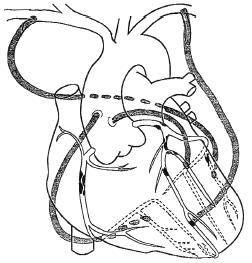

| PREOPERATIVE PLANNING |
Beating heart CABG requires a preoperative plan for the revascularization
procedure that is different from CABG with CPB. In CABG with CPB, global
ischemia is caused by aortic cross-clamping and cardioplegic arrest.
Global ischemia is then managed by decreasing myocardial oxygen demand.
In beating heart CABG, normothermic regional ischemia is managed by
minimizing the area of ischemia. It is therefore critical to have a
preoperative grafting strategy to minimize the amount of myocardium
subjected to each ischemic episode.
|
Angiogram review:
Minimize normothermic regional ischemia:
|
 Figure 1. Coronary and graft placement |
|
|
|
62-year-old white male status post MI and angioplasty in 1988 presents with increasing fatigue upon exertion. Cardiac Catheterization Results (Figure 1)
Beating Heart Grafting Sequence 1. LIMA to LAD: Occlusion time – 8 minutes
2. RIMA to OM-1 via the transverse sinus: Occlusion time – 11 minutes
3. SVG to diagonal artery: Occlusion time – 8 minutes
4. Proximal grafts for the diagonal and PDA
5. SVG to PDA: Occlusion time – 8 minutes
"Anterior wall vessels are usually grafted first. If both the LAD and diagonal grafts are planned, the diagonal is grafted first, followed by the LIMA to LAD. Following anterior grafting, usually right coronary branches are approached next. Last but not least, the marginal branches of the circumflex artery are grafted. I do the proximals after all of the distals are completed."12 -James C. Hart, M.D. Surgeon The general concepts presented above are guidelines and can be adapted to meet surgeon preferences. |